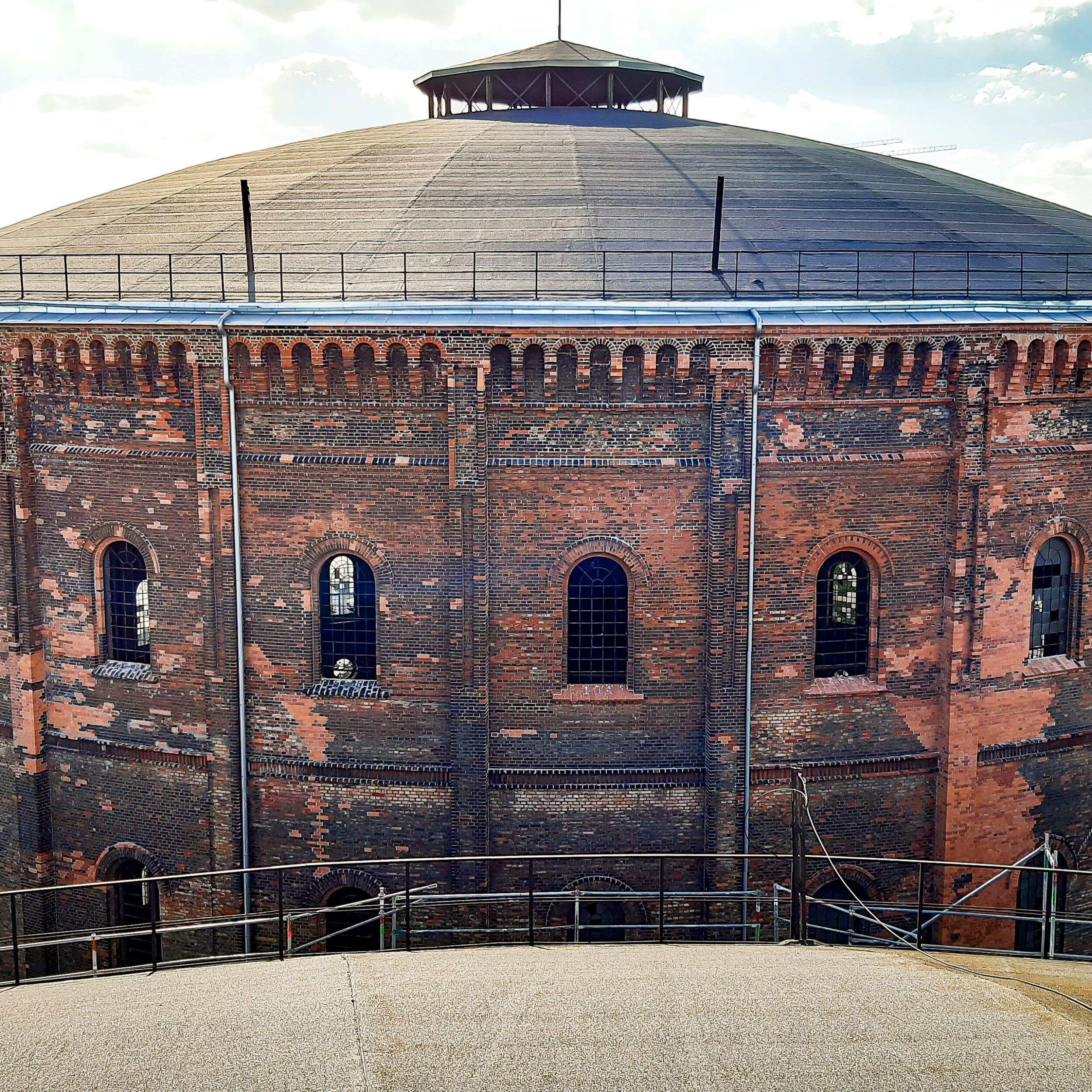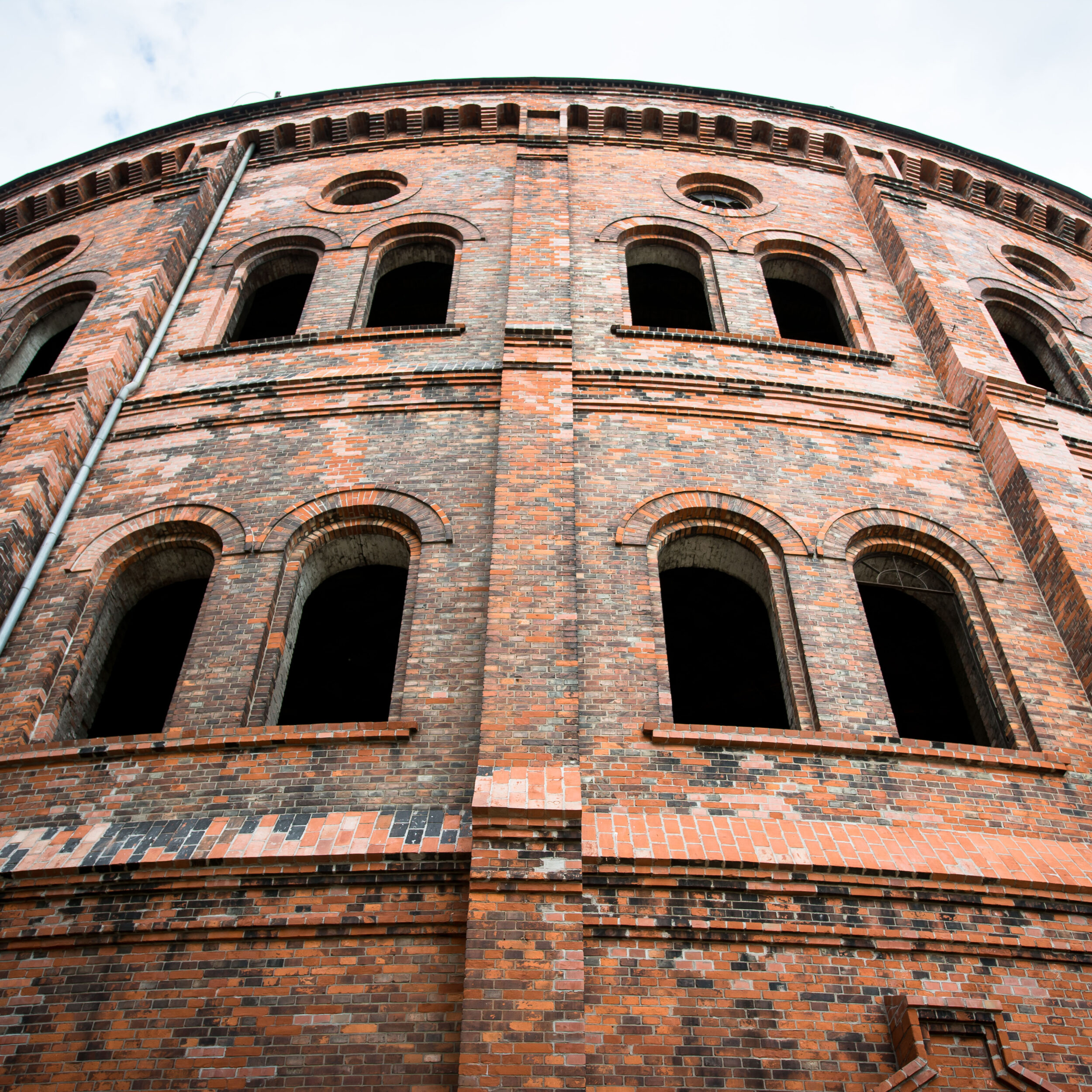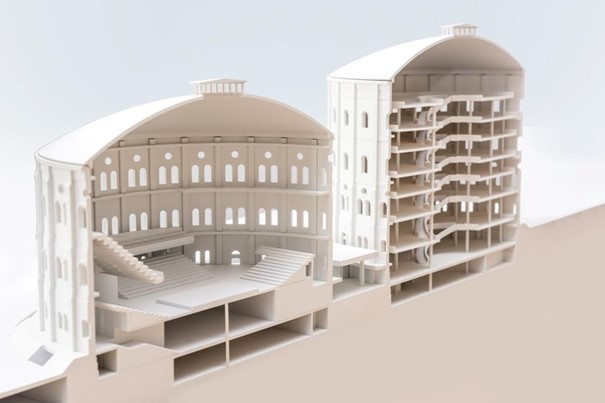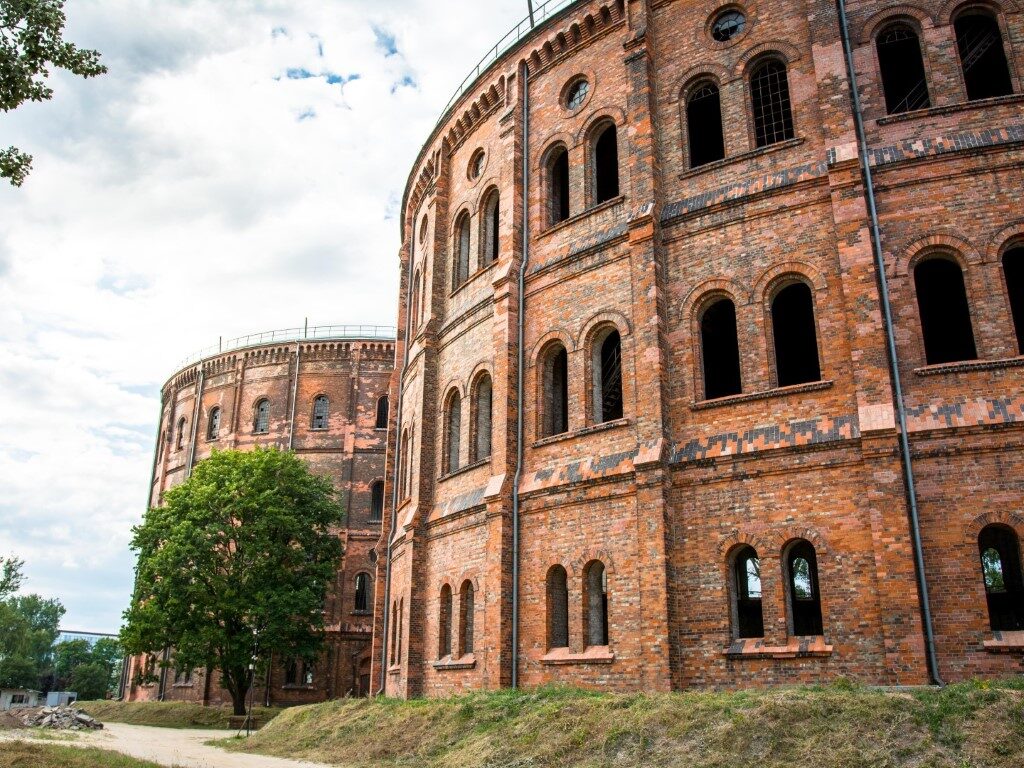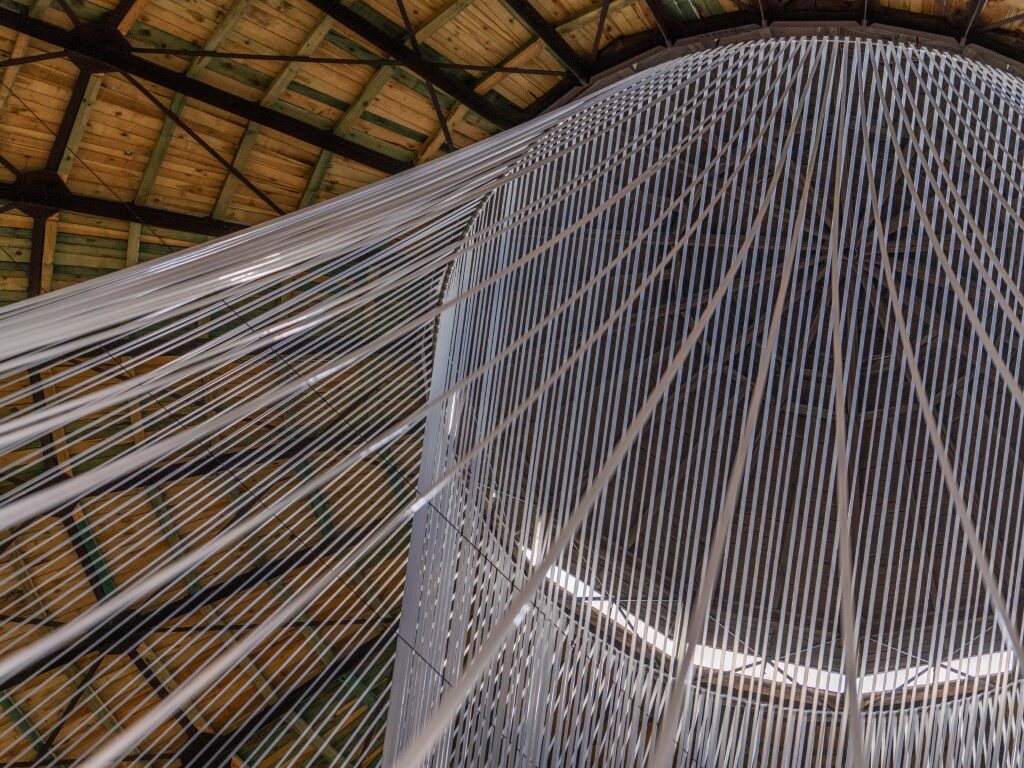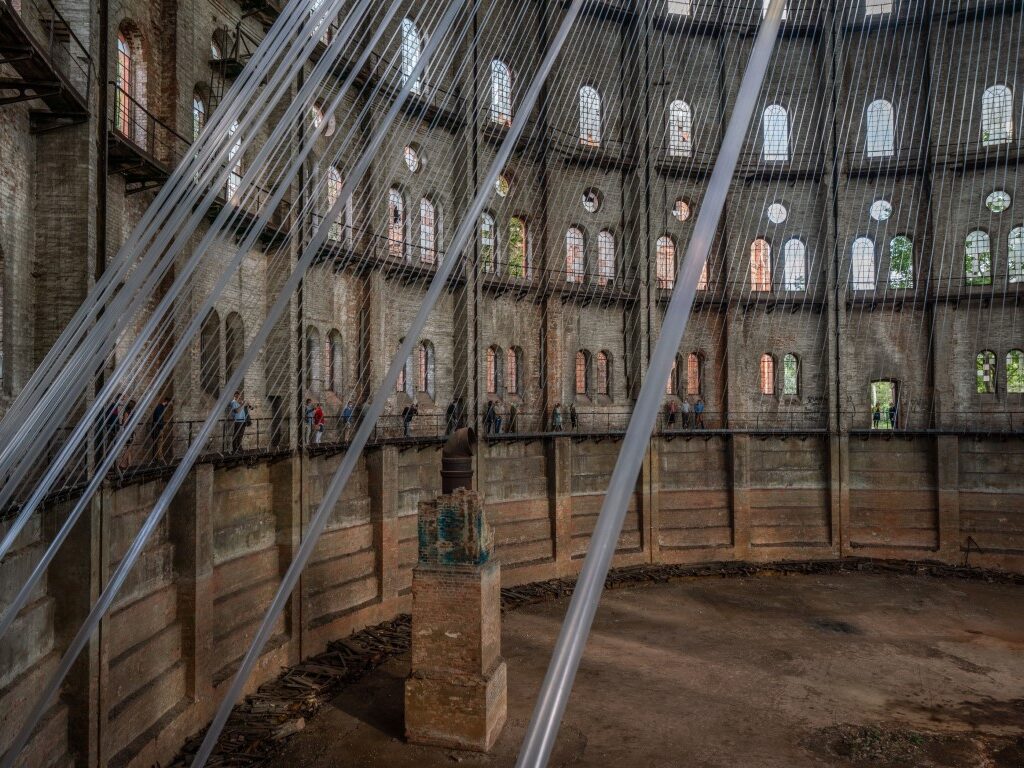Widely nicknamed the Wola Colosseum, one of Warsaw’s most identifiable landmarks has been returned to life courtesy of a striking art installation that has made news as far afield as China.
The brainchild of artist Danuta Karsten, the project – titled Stability In Volatility – is the latest initiative to mark the ongoing revival of a pair of giant brick rotundas originally built to store gas in the 19th century.
 Stretching from top-to-bottom in the shape of an inverted cone, and moving softly with each breath of wind, Karsten’s installation has wooed both the public and the art world.Kalbar/TFN
Stretching from top-to-bottom in the shape of an inverted cone, and moving softly with each breath of wind, Karsten’s installation has wooed both the public and the art world.Kalbar/TFN
Comprised of 240 transparent plastic tubes, each 104-metres long and approximately 3.5 centimetres in diameter, the work has reinvigorated interest in one of the capital’s most curious buildings and launched it back into the spotlight after years of neglect.
Originally scheduled to close on October 15th, such has been the exhibition’s success that its lifespan has now been extended until October 31st.
 With its appearance shifting with both the weather and the time of day, one visit feels unsatisfactory.Kalbar/TFN
With its appearance shifting with both the weather and the time of day, one visit feels unsatisfactory.Kalbar/TFN
Completed in 1888 and 1912 respectively, the purpose of the twin rotundas was straight forward – to keep the city supplied with gas. Providing enough work for over 1,200 employees, the tanks produced 140,000 cubic metres of gas daily and helped light in excess of 92,000 homes not to mention streets such as Nowy Świat.
 Seeking to create “an event-like experience in the here and now”, and purposefully designed to “turn this cathedral of industry into a sacred space”, rarely has an installation created such a visual and emotional impact.F. Rainer Schlautmann
Seeking to create “an event-like experience in the here and now”, and purposefully designed to “turn this cathedral of industry into a sacred space”, rarely has an installation created such a visual and emotional impact.F. Rainer Schlautmann
Hit by German artillery on September 8th, 1939, the structures faced further damage five years later when the Warsaw Uprising broke out. Resuming production after the war, they continued to function for several decades until being finally decommissioned in 1978.
Allowed to slip into decline thereafter, for years the future of these listed buildings became a celebrated bone of contention: at one stage, a case was made to house the Warsaw Uprising Museum inside their hulking mass, whilst other ambitious plans envisioned their transformation into luxury apartments.
 Karsten told TFN: “The effect of the light pouring through the windows was just incredible – I fell in love!”Kalbar/TFN
Karsten told TFN: “The effect of the light pouring through the windows was just incredible – I fell in love!”Kalbar/TFN
Fenced off from the general public, general procrastination saw them decay yet further and they became better known as one of the country’s favourite destinations for urban exploration. Conspicuous on the skyline, their degradation was to become a continuing source of embarrassment for the city, and it wasn’t until racing driver Marcin Biernacki intervened that their degeneration was halted.
 Completed in 1888 and 1912 respectively, the purpose of the twin rotundas where the installation can now be seen was straight forward – to keep the city supplied with gas.Kalbar/TFN
Completed in 1888 and 1912 respectively, the purpose of the twin rotundas where the installation can now be seen was straight forward – to keep the city supplied with gas.Kalbar/TFN
Planning to ultimately turn the towers into an interactive technology museum and concert hall, it was his foresight that allowed Karsten the opportunity to realize her project.
Having first been staggered by the colossal immensity of the towers last August, the Polish-German artist met Biernacki in January of this year and found him eager to cooperate.
 Providing enough work for over 1,200 employees, the tanks produced 140,000 cubic metres of gas daily and helped light in excess of 92,000 homes not to mention streets such as Nowy Świat.Kalbar/TFN
Providing enough work for over 1,200 employees, the tanks produced 140,000 cubic metres of gas daily and helped light in excess of 92,000 homes not to mention streets such as Nowy Świat.Kalbar/TFN
“We had a very interesting conversation,” Karsten tells TFN. “He’s very open-minded and totally committed to his fantastic plans for the rotundas. When I approached him he didn’t think for a second and immediately agreed to host my project.”
Having previously only viewed the rotundas from the outside, it was then that Karsten was first able to peer inside these echoing structures.
 Kalbar/TFN
Kalbar/TFN
 Kalbar/TFN
Kalbar/TFN
 Kalbar/TFN
Kalbar/TFN
“I had goosebumps,” she says. “It was fabulous to see them up close, and actually quite emotional. The first time it was one of those grey, overcast days but then the following day the weather brightened and I was able to see the buildings against a bright, blue sky. The effect of the light pouring through the windows was just incredible – I fell in love!”
 After being hit during WWII, over the years the rotundas fell into neglect until racing driver Marcin Biernacki looked at turning them into an interactive technology museum and concert hall. Kalbar/TFN
After being hit during WWII, over the years the rotundas fell into neglect until racing driver Marcin Biernacki looked at turning them into an interactive technology museum and concert hall. Kalbar/TFN
Describing the complex as a “pearl of Warsaw architecture”, Karsten began work on her installation in July, aided by a team of volunteers that numbered friends and family as well as professional mountaineers.
Challenges, though, were abundant.
 With Biernacki agreeing to cooperate with Karsten, when she got the opportunity to look inside she said she had “goosebumps.”F. Rainer Schlautmann
With Biernacki agreeing to cooperate with Karsten, when she got the opportunity to look inside she said she had “goosebumps.”F. Rainer Schlautmann
“It’s the largest facility I’ve ever worked in,” she says, “and among the issues I faced were my own fear of heights! The nature of the building limited technical possibilities while the pandemic meant it was impossible to test the way the materials behaved before they were assembled – I didn’t know how they’d react to changing weather conditions.”
 Describing the complex as a “pearl of Warsaw architecture”, Karsten began work on her installation in July, aided by a team of volunteers that numbered friends and family as well as professional mountaineers.F. Rainer Schlautmann
Describing the complex as a “pearl of Warsaw architecture”, Karsten began work on her installation in July, aided by a team of volunteers that numbered friends and family as well as professional mountaineers.F. Rainer Schlautmann
The results have been stunning.
“You could say that it’s definitely met my expectations,” she says. “Before implementing such a project I build mock-ups so as to study the effects of light, but to see it create such a wonderful dialogue within the context of real architecture has been great. I think it’s an emotional work that grabs the soul, and that’s possibly why it’s proved such a success.”
Stretching from top-to-bottom in the shape of an inverted cone, and moving softly with each breath of wind, Karsten’s installation has wooed both the public and the art world.
 Originally scheduled to close on October 15th, such has been the exhibition’s success that its lifespan has now been extended until October 31st.Kalbar/TFN
Originally scheduled to close on October 15th, such has been the exhibition’s success that its lifespan has now been extended until October 31st.Kalbar/TFN
“Even the gentlest breeze brings the structure into motion with soft sounds emanating from it in stark contrast to the rigid historic form of the building,” says Karsten.
“The installation takes up the interior volume of the former gasometer and is uniquely contoured and centred by it, and yet it still maintains its organic appearance. This effect is not caused by its physical mass, but by the real and virtual spatial dynamic.”
 Kalbar/TFN
Kalbar/TFN
Designed to catch the breath of visitors, the tubing that comprises the installation is Karsten’s own subliminal homage to the heritage of the structure. “The building once supplied warmth to countless homes and people – now, descendants of these very people will supply it with their own warmth through their breath.”
With its appearance shifting with both the weather and the time of day, neither does one visit feel satisfactory. Seeking to create “an event-like experience in the here and now”, and purposefully designed to “turn this cathedral of industry into a sacred space”, rarely has an installation created such a visual and emotional impact.

